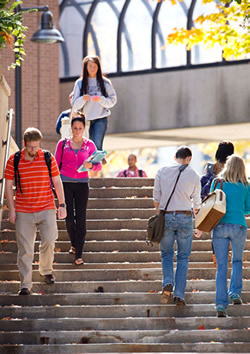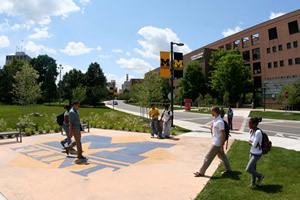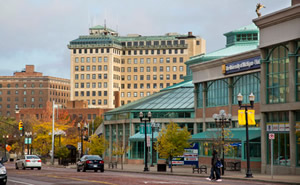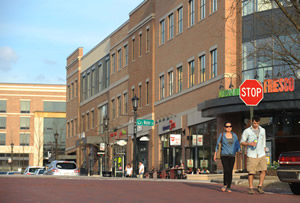Creating a Strong Town-Gown Relationship
 Remember the Kent State University (KSU), Ohio, shootings in 1970? You can imagine that it made for a poor town-gown relationship. Forty-three years later, things have turned around — city and university officials are collaborating to ensure the success of both entities. “Our relationships are very strong and our collaborations are numerous and tightly woven,” says Shay Davis Little, Ph.D., KSU’s associate vice president for Student Affairs and dean of students in the Division of Enrollment Management and Student Affairs.
Remember the Kent State University (KSU), Ohio, shootings in 1970? You can imagine that it made for a poor town-gown relationship. Forty-three years later, things have turned around — city and university officials are collaborating to ensure the success of both entities. “Our relationships are very strong and our collaborations are numerous and tightly woven,” says Shay Davis Little, Ph.D., KSU’s associate vice president for Student Affairs and dean of students in the Division of Enrollment Management and Student Affairs.
For example, a multifaceted downtown project is designed to bring students downtown, connect the town to on-campus events, provide employment downtown and increase revenue for both partners. It begins with the KSU Gateway-Esplanade, a walkway that connects the campus’ 28,000 students to the city’s downtown area. Next, new development includes a hotel and conference center sponsored and managed by the KSU Foundation. Finally, a multimodal transit station and garage next to the hotel were sponsored by a Transportation Investment Generating Economic Recovery (TIGER) grant from the U.S. Department of Transportation. “Retail shops and additional businesses in the area were a collaboration between the city and private developers,” says Little, “so that the entire project is a true collaboration of many individuals at many levels.” In fact, the development won the Ohio Economic Development Association’s 2012 Best Project of the Year award.
THE UNIVERSITY OF MICHIGAN-FLINT
In Michigan, the University of Michigan-Flint (UM-Flint) also has a strong relationship with the City of Flint. “We’re in a marriage with the City of Flint that will not end with a divorce, regardless of who the chancellor or mayor are,” says David E. Lossing, director of Government Relations at UM-Flint. “The marriage includes economic development, public safety, fire professionals and more. It’s a lot of effort, but it’s a relationship that has to be maintained to help the city define itself in the new economy and shed light on how the university can contribute to that definition.”

PHOTOS © SCOTT GALVIN PHOTOGRAPHY
To that end Flint officials are undertaking a master plan update — the first in 40 years. “We have a number of our faculty, staff and students assisting with the update,” says Lossing, who also serves as mayor of the city of Linden and president of Ann Arbor-based Michigan Municipal League (MML), a statewide organization representing 530 municipalities that works to create better communities on a number of levels. He adds that UM-Flint administrators updated their master plan two years ago and have shared it with city officials to help inform what they want to do, how it speaks to changes in the community and how the two fit together.
In another project, UM-Flint administrators are working with administrators at nearby Kettering University to build a safety corridor between the two campuses. “The campuses are separated by 20 city blocks with a former manufacturing facility between us,” says Lossing. “We want to enhance the space between us, making it safe and attracting new residents.” The project involves a number of local organizations, some of which include the Flint Police Department, campus public safety officers, neighborhood organizations, Hurley Medical Center, Genesee County Sheriff’s Department, the FBI and Michigan State Police.
THE CHALLENGES
 Both KSU and UM-Flint are examples of strong town-gown relationships — the association between the town in which a campus is located and the campus’ students, faculty and staff. In this time of sloth-like economic recovery, town-gown relationships are flourishing as the two institutions come together to make their communities better places to live and their campuses more attractive to students.
Both KSU and UM-Flint are examples of strong town-gown relationships — the association between the town in which a campus is located and the campus’ students, faculty and staff. In this time of sloth-like economic recovery, town-gown relationships are flourishing as the two institutions come together to make their communities better places to live and their campuses more attractive to students.
The effort isn’t without its challenges. For example, one issue is determining, in the case of shared services, what is each entity’s fair share contribution. “Another is determining what the university can bring to the table and what the host community expects of the university,” says Beth Bagwell, MPA, program director for the International Town-Gown Association (ITGA), Clemson, SC, which provides a network of resources to assist civic leaders, university officials, faculty, neighborhood residents and students to collaborate on common services, programs, academic research and citizen issues, creating an improved quality of life for all residents, students, visitors, faculty and staff.
ITGA is working to get a handle on what’s going on in town-gown relationships. To that end, it recently completed a pilot survey, which collected information around five themes: economic development initiatives, shared services, friction points, campus edge development and off-campus student housing. The survey will continue on an annual basis, and will be refined along the way. “It will help us identify hurdles that need to be overcome and opportunities for partnerships,” says Bagwell. Short-term goals include using survey results to inform benchmark surveys in future years. Long-term goals include establishing a “best practices” database and tracking trends both nationally and regionally.

PHOTO COURTESY OF KENT STATE UNIVERSITY
MAKING THE CONNECTION. Kent State University students enjoy some of the new stores in College Town Kent (collegetownkent.com), a pedestrian-oriented shopping, office and lifestyle center developed by Fairmount Properties and its partners. The 185,000-square-foot development in downtown Kent, OH, includes the new AMETEK and Davey Tree buildings. Seen in the background is the new Kent State University Hotel and Conference Center.
WORK CONTINUES
MML is working just as hard to assist in strengthening town-gown relationships in Michigan. “It’s no secret that Michigan has been hurt economically more than most states through the last couple decades,” says Dan Gilmartin, MML’s executive director and CEO. “With industrialization moving out of the country, we’ve seen a decline in the quality of our communities and per-capita income.” In studying other communities, MML has seen a lot of base-level communication and even more strategic communication between colleges and their cities, “but it’s something we want to ramp up,” he says. “We want to get outside the structure of the two entities representing two separate things at the table, and get inside them representing one thing: a community moving forward economically.”
KSU has turned around its negative relationship with the City of Kent. UMFlint is partnering with the City of Flint to heal economic wounds. With strong town-gown relationships, both partners win. A university with strong programs and a welcoming campus attracts high quality students, who find additional services and activities in an inviting off-campus community. A town creates a safe environment, provides desirable services, shopping and entertainment, which draws business, encourages recent graduates to stay and increases the tax base. Go for it.
Ideas for Getting Started
As campus administrators approach their community leaders, extending the right hand of collaboration in building strong town-gown relationships, the experts have some advice.
Build.
“Make time to get to know your city leaders and involve yourself in your local community,” says Shay Davis Little, Ph.D., associate vice president for Student Affairs and dean of students in the Division of Enrollment Management and Student Affairs at Kent State University in Ohio. “It takes initiative and giving initially to show that a partnership can be beneficial, but it allows people to see that there will be many positive outcomes.”
Meet.
Start with a joint city/university advisory board that meets regularly. “It’s an intentional way to get conversations started,” says Beth Bagwell, MPA, program director for the International Town-Gown Association (ITGA), Clemson, SC. “Include anyone you feel needs to be at the table, such as the Chamber of Commerce and the Chief of Police.”
Communicate.
“Communication creates opportunities to sit together and talk about where both parties are headed,” says Dan Gilmartin, executive director and CEO of Michigan Municipal League (MML), Ann Arbor. “It’s a time to talk about shared goals and visions, and I believe it doesn’t take long to find an agenda that you can accommodate.” Trust. “Trust comes from a shared future,” says Gilmartin. “Having a shared understanding of where you want to go and trust among the people around the table is a good start. It’s not that difficult because it just makes sense to have better relationships in this tough economic time.”
Believe.
“Believing that a collaborative and strong relationship will yield benefits to the community beyond what either entity can do alone is critical,” says Little. “Talk among leadership on both sides has to include belief that giving a little and sharing a lot will benefit each more than if each operates on its own.”
This article originally appeared in the College Planning & Management August 2013 issue of Spaces4Learning.